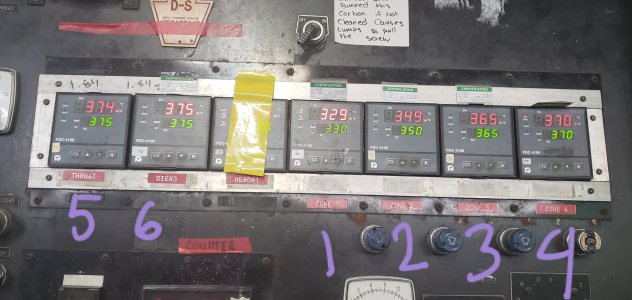@strantor I'm really glad that you've tried the CHT. Where I am going with this is that a longer heat path can be collapsed into a shorter nozzle...
You are hoping for a smooth path. A frictional path can induce chaotic flow as the filament liquefies, presenting lower temperature fragments to the hot walls.... Industrial filament machines use a very long heat path with polished paths, but those units use higher pressures and screw extrusion to liquify the plastic.
I applaud your work towards getting better extrusion for TPU.... a little troublesome on some commercial 3DP.
I am about to say a lot of "I think" and "to me it seems" stuff here. It's annoyingly non-committal I know, but I am not a material scientist and am just trying to explain the conclusions I have made based on first hand observation.
The problem as I see it, is that in most cases, a 3d printer is not actually
melting the plastic. Or, not melting it completely. A 3d printer running at a "normal" speed (ex: for PLA) I suspect, is just getting the filament soft enough to force through a hole. In this video you can see what I mean, he starts talking about it around 16:00 or shortly thereafter, calling it "cold core extrusion" and gives good visuals of it.
He implies that it only happens at high-speed open-air testing, but I suspect that it is happening all the time, to greater or lesser extents, depending on material type, temperature, and print speed.
Some might say that "getting the filament soft enough to force through a small hole"
IS melting it. Not in my book. To me,
melting means turning the filament into a homogeneous viscous fluid that is the same temperature and consistency throughout, from OD to center.
The CHT solution I think works well for most filaments because it splits the "cold core" of the filament into 3 smaller filaments which are easier to individually melt (homogeneously liquefy). This is great when the filament is strong enough to really stand some pressure on its head and force through this 3-hole cheese grater. But for a filament that isn't strong enough to apply any pressure to, the cheese grater is just a restriction.
I am not sure if you have tried working with any of these super soft filaments like 60A, but it is a whole different ball game. Without embellishing I can say it is like a well done spaghetti noodle that has the elasticity of a rubber band. You can't apply much pressure to it at all before it goes "sproioioing" and pops laterally out from between the extruder gears. I think we are "brute forcing" filaments through the hotend as a course of normal operation but it just doesn't work for these softer filaments. I think the reason why "just slow down" works, is that it gives the filament time to actually
melt (not just soften enough to force through a hole) as it passes through this laughably tiny melt zone. But if we can actually melt the filament without slowing way down to do so, then I think it solves most of the issue.
So I think the melt zone needs to be as long as possible to give the filament plenty of opportunity to melt, and it needs to be as unrestrictive as possible so that not much extrusion pressure is necessary (because we can't apply much). It should be something that ordinary filament would just "fall through" under its own weight if there were no extruder gears. Very finely polished walls, no cheese grater, and as large a nozzle as one can get away with. The motor can be something pathetically small. Where a normal extruder might be 80% motor and 20% hotend, a super soft flexibles extruder should be 20% motor and 80% hotend.
Those are my hypotheses and assumptions and they are soon to be proven or disproven, I will post updates. But I think, if it works, it actually should for normal filaments as well; I think the theory is still valid. I think we only do the brute force thing because that's how we've always done things, and I'm only trying this other way because "just slow down" tastes to me almost like a personal insult.


